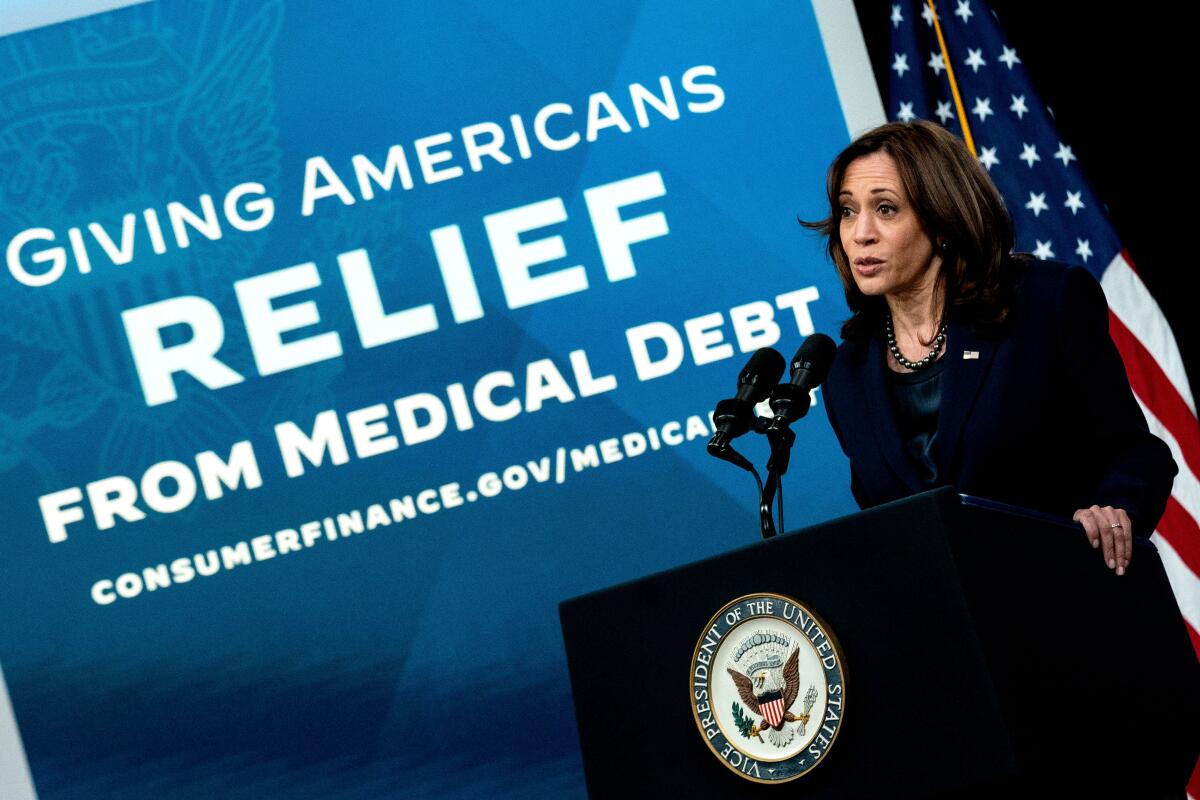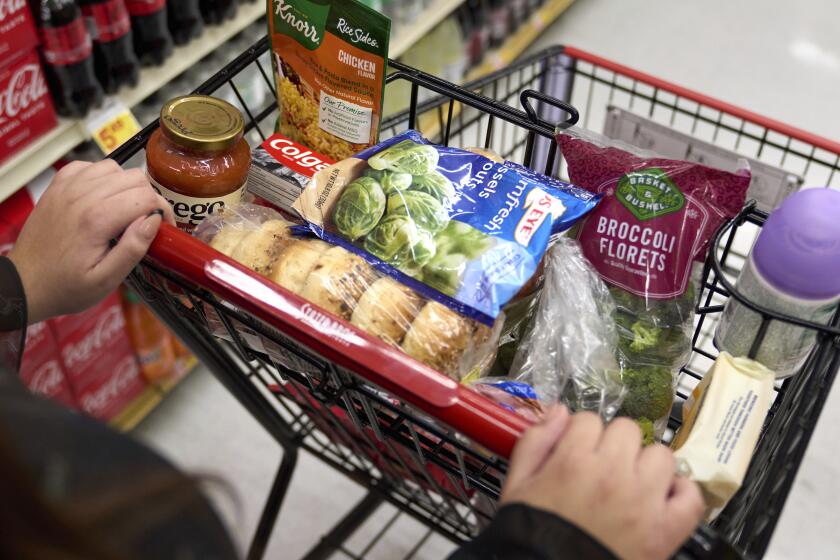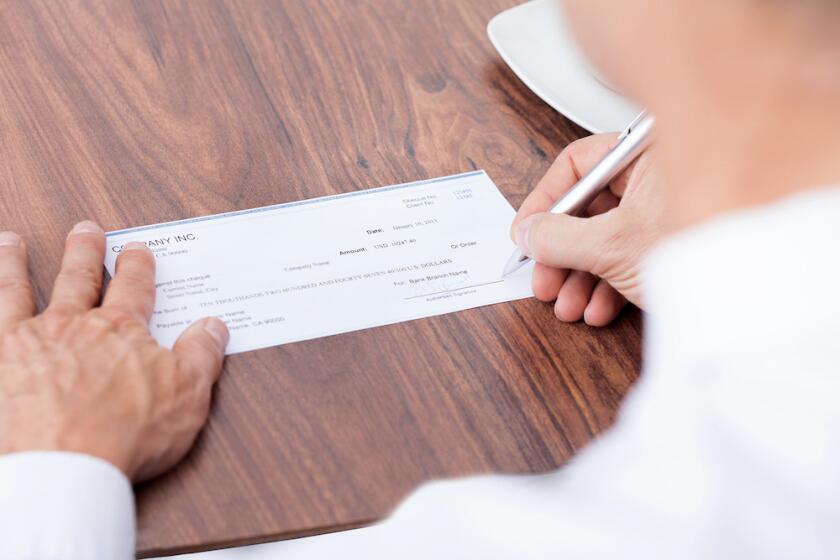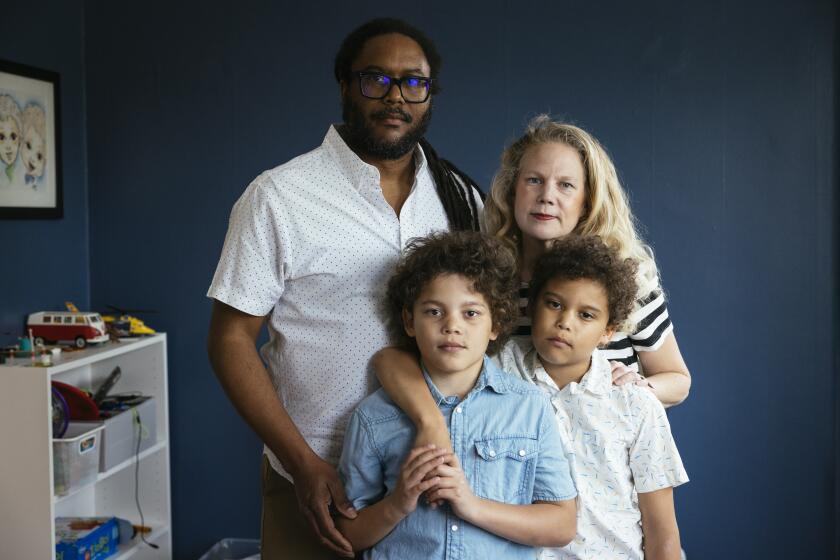Medical bills pushed a Santa Monica family into poverty. They’re not alone

- Share via
One in 10 Los Angeles County residents are burdened with medical debt, according to new research from Los Angeles County’s Department of Public Health.
And often even relatively small amounts of debt can plunge a patient into a financially precarious situation.
In 2021, 11.3% of L.A. County adults with medical debt owed on average more than $4,000 and about a third owed less than $1,000. Fifty percent reported taking on credit card debt to finance their medical bills, and 46% said they were unable to afford basic necessities due to their bills.
About half of those who took on credit card debt or were struggling to pay for necessities owed less than $2,000, the report said.
In L.A. County, 810,000 residents collectively are carrying more than $2.6 billion in medical debt as of 2021, the most recent data available, according to the health department.
Consumers are switching grocery stores, brands and ingredients as they try to cope with the cost of food.
It’s a uniquely American issue: In the United States, medical debt is the largest source of debt in collections — more than credit card, utilities, and car loans combined — and one of the leading causes of bankruptcy. And anyone is vulnerable, even the insured.
“There’s ways that medical debt could not only put people in financial jeopardy, but also could actually worsen their health,” said Dr. Will Nicholas, the director of the center for health impact evaluation at the Department of Public Health, who worked on the data analysis in the report.
Alice Manning, 63, who lives in Santa Monica, has been in medical debt for two decades.
Manning gave birth to twins in 2002, one of whom has cerebral palsy and a seizure disorder. While in neonatal intensive care immediately after his birth, her son Aidan contracted a bacteria that caused a massive stroke, leading to a cranial bleed and six brain surgeries.
Manning and her husband had insurance at the time, but due to the acute medical needs of their son, both soon stopped working. Her husband has since returned to a career in solar sales.
Inflation has a way of affecting nearly every aspect of your finances, including the size of your tax refund and your retirement contributions.
“And then that started that trajectory of, really, poverty for the next 15 years or so,” Manning said.
The family amassed around $6,000 in medical debt, which they were never able to pay back.
“It ruined my husband’s credit,” she said.
That was just the beginning: Manning’s oldest daughter broke her arm on her first day of middle school, resulting in an $800 ambulance bill. Her other daughter recently received a $2,000 bill for services that were unexpectedly not covered by her university’s insurance. And Aidan has weekly out-of-network chiropractor visits to keep his spine straight.
Although the uninsured are most likely to have medical debt, the insured also can be vulnerable. More hospital visits are correlated with more debt, whether or not a patient has insurance. The report found that adults who visited the emergency room one or more times in the last year were twice as likely to be burdened with medical debt than someone who didn’t go to the emergency room at all. People who spent at least one night in the hospital in the last year were more than 2.5 times as likely to be burdened with medical debt than someone whose visit did not include an overnight stay.
The U.S. health system now produces debt on a mass scale, an investigation shows. More than 100 million people are affected, far more than previously reported.
It’s still crucial to have insurance, researchers said, but having it is not a panacea. Even adults on private health insurance plans through a stable employer can find themselves overwhelmed by debt, thanks to plan exclusions, surprise bills, and “exorbitant hospital costs.”
Dr. Naman Shah, the director of the division of medical and dental affairs at the L.A. County Department of Public Health, blames the sheer cost of insurance for this phenomenon in addition to the cost of premiums and high deductible plans, which have been increasing. He believes that resolving this issue requires further work at the state level.
“Health insurance is important, and having any health insurance is better than having no health insurance, But we especially want Medi-Cal, which protects our most vulnerable residents, to protect them from further debt,” Shah said.
Andrea Santibanez, 38, was hit with a surprising medical bill when she was pregnant in 2020. The downtown L.A. resident was going to routine checkups with her OB-GYN when her Medi-Cal insurance lapsed. She still doesn’t know why, but thinks her renewal paperwork was never received.
After one visit, she got a bill for $5,000 and panicked.
“And I’m like, why did I get a bill if I have insurance?” she explained to the doctor at the time. “But then they said ‘no, you didn’t renew your insurance.’ I was like, Yes, I did!”
Once both parties realized what had happened, Santibanez reactivated her Medi-Cal plan, but it took five months before the agency cleared the debt. “It’s hard when you have Medi-Cal when something goes wrong. It takes a while for them to figure out what’s going on,” she said.
The percentage of adults with medical debt stayed “virtually unchanged” between 2017 and 2021 according to the report, a troubling finding for the researchers, who note that the number of uninsured residents in Los Angeles fell in that time. “Given that this was a period of expansion of insurance coverage, you would expect those numbers to go down and they didn’t,” Nicholas said.
This creates a trickle-down effect, harming the sickest residents of L.A. County, who rely on healthcare systems most severely. People with medical debt are 2.5 times more likely to be food-insecure, three times more likely to delay or forgo necessary healthcare and 3.5 times more likely to delay or not pick up necessary prescriptions.
“How much medical debt you have shouldn’t have anything to do with your health,” Nicholas said, but “that was the biggest finding that we had.”
The report also found that Latino, Black, and Native American residents were more burdened by medical debt than White and Asian residents. Adults in households with children were 37% more likely to have medical debt than adults in households without children.
The emergence of medical credit cards and other third-party payment options — which often come with alarmingly high interest rates — can also trap those who are already struggling to pay for services in a cycle of debt. “We know this happens in L.A. County,” Shah said. “Part of the next steps and the work we’re doing is measuring and mapping out exactly how prevalent it is.”
In 2019, Manning was diagnosed with non-Hodgkin’s lymphoma. Even before the diagnosis, she knew something was wrong — she had to sleep in a recliner because she experienced a choking sensation while lying flat on her back. But since her husband was between jobs, she didn’t have insurance, and she tried to wait it out. “I was afraid to go to the emergency room because we had no insurance,” she said. “And finally I just said screw it. I’m going to the hospital.” Fortunately, a social worker at the hospital helped her sign up for emergency Medi-Cal.
Now, Manning estimates she has around $4,000 in medical debt.
Navigating the medical establishment for her family and disputing charges takes a toll. “I literally have spent hundreds of hours on this,” Manning said. “And if we had national healthcare, I could have been able to have a career, you know? It’s very, very frustrating that our whole lives revolve around whether we can get healthcare.”
More to Read
Inside the business of entertainment
The Wide Shot brings you news, analysis and insights on everything from streaming wars to production — and what it all means for the future.
You may occasionally receive promotional content from the Los Angeles Times.














